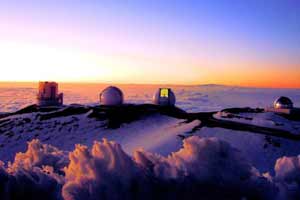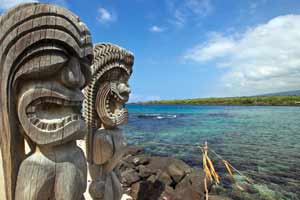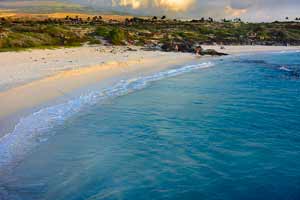
The futuristic, Moon-like landscape of
Mauna Kea summit, dotted with observatories, is one the of most famous images that the Big Island is known for. Mauna Kea is a million years old, dormant volcano, rising 13,802 feet (4,207m) above sea level, making it the highest point in the state of Hawaii and the second highest point of any island on the planet. If measured from the bottom of the ocean, the summit is over 33,000 feet (10,000m) high. The mountain is sacred to Hawaiians and in the past only members of the Royal family could go to its peak. The summit is one of the best places on Earth to stargaze, because of the high altitude, thin and clear air and the lack of bright city lights. The area is home to some of the world’s most powerful telescopes, including the Keck Telescope with the world’s largest mirror.
If you are looking to find out more about the history, culture and community spirit of the Big Island and Hawaii in general, Mokuaikaua Church should be your first stop. This is the oldest and first Christian church on the island, completed in 1837 by the congregation that was first founded in 1820.
Next on your list should be the Puuhonua o Honaunau National Historical Park – the Place of Refuge Park. This is a 180-acres national historic park that was once the home of Royal grounds and a place of refuge for ancient Hawaiian lawbreakers.  See the 12-feet tall and 18-feet thick Great Wall that the people who broke the wall needed to climb to escape their pursuers and receive absolution by a priest. Admire the fierce ‘kii’ – wooden images of Gods, guarding the Hale o Keawe Heiau, a sacred temple, housing the bones of 23 Royals. Your third stop should be the Hulihee Palace – a formal holiday home of King Kalakaua and Queen Kapiolani, today this is a museum, showcasing beautiful Victorian furniture, ornaments and artefacts from the Royal past. The Kaloko-Honokohau National Historical Park is another ancient site, where you can get to know how the ancestors of Hawaiians lived, in the spirit of Kaloko-Honokohau. See their fishponds, kahua (house site platforms), ki’I pohaku (petroglyphs), holua (stone slides) and heiau (temple). Kealakekua bay State Historical Park marks where Captain James Cook – the first westerner to ever enter the shores of Hawaii, landed, and found his death a year later. The site is also a home to other archaeological and religious sites, but also a marine life conservation area and a popular spot for kayaking, scuba diving and snorkelling.
See the 12-feet tall and 18-feet thick Great Wall that the people who broke the wall needed to climb to escape their pursuers and receive absolution by a priest. Admire the fierce ‘kii’ – wooden images of Gods, guarding the Hale o Keawe Heiau, a sacred temple, housing the bones of 23 Royals. Your third stop should be the Hulihee Palace – a formal holiday home of King Kalakaua and Queen Kapiolani, today this is a museum, showcasing beautiful Victorian furniture, ornaments and artefacts from the Royal past. The Kaloko-Honokohau National Historical Park is another ancient site, where you can get to know how the ancestors of Hawaiians lived, in the spirit of Kaloko-Honokohau. See their fishponds, kahua (house site platforms), ki’I pohaku (petroglyphs), holua (stone slides) and heiau (temple). Kealakekua bay State Historical Park marks where Captain James Cook – the first westerner to ever enter the shores of Hawaii, landed, and found his death a year later. The site is also a home to other archaeological and religious sites, but also a marine life conservation area and a popular spot for kayaking, scuba diving and snorkelling.
Other interesting sites to see in and around Kona are the Kona’s Farmers Market, the Hualalai volcano and nature reserves, the Kohala waterfalls.  A fun activity would be to visit the unique seahorse farm and hold a seahorse, or the octopus farm where you can feed one!
A fun activity would be to visit the unique seahorse farm and hold a seahorse, or the octopus farm where you can feed one!
Last, but not least, pick and choose from the many beaches near Kona – Kahalu’u Beach Park is the best for snorkelling, Makalawena Beach – hidden gem, difficult to get to, Magic Sands Beach Park is very close to Kona, Honokohau Beach – also called salt and pepper beach, Ho’okena Beach Park – a historical site of one of the last active Hawaiian canoe fishing villages, Honl’s Beach for great sunset shots, Manini’owali Beach – beautiful white sand beach and a chance to see dolphins and humpback whales, Punalu’u Black Sand Beach for seeing Hawksbill turtles and green turtles.